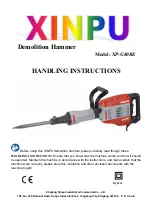
Page.:
20
Code.:
000013BG
Chapter:
3
This document is the property of the Manufacturer and/or its
Agent and must not to be tampered with or changed, reproduced or provided to others without written consent.
RESIDUAL RISKS
Despite the warnings and safety systems that the Manufacturer has
adopted, there are still some residual risks that cannot be eliminated.
These risks are listed in the table below, with some suggestions to
avoid them.
Table: Residual risks
RISK ANALYSIS AND DESCRIPTION
A risk of crushing
of the upper limbs is inevitably present and cannot
be eliminated. Be very careful when using the machine. respect any sa-
fety distances. Moreover, on magazines or dispensers can be mounted
some wheels that cause crushing danger if not correctly blocked.
Leaks or seepage
with a danger of slipping and/or environmental
pollution.
Noise pollution
due to the type of machining or wrong pressure setting
conditions.
Guards must only be opened
after working ended to avoid the risk
of
residual voltages and allow the temperature of hot components
to diminish
.
Aggressiveness and toxicity of fluids or greases
: Hydraulic oil and
some greases may attack the skin or mucous membranes.
Cutting parts
: Any burrs on the stub hoses or bushing being machined,
dies
06
or shells
12
damaged etc.
The hydraulic system
may cause serious injury if used with excess
pressure.
Poor cleaning
: This makes it difficult to read the controls and safety
signs and creates dangerous situations.
External weather agents
such as infiltration of water, low or high
temperatures, high humidity, etc.
Accumulation of energy
: inside the control panel
13
or hydraulic or
pneumatic accumulators (if fitted).
The
main switch IG
and other devices (by request) are fitted with
locking systems.
Format change or Set-Up errors
with serious damage to the machine.
Poor or no
lighting
in the workplace.
Installation in small spaces
that do not allow adequate movements
or correct escape routes from the workplace in case of danger.
Poor training
of personnel involved or professionals that work with
the machine.
SUGGESTED SOLUTION
During pressing do not move your hands
near to the dies and keep a minimum
distance of 120 mm.
always use proper brakes.
Clean the machine and workplace tho-
roughly.
Check the settings and operation or pro-
vide additional insulation.
Do not open the guards before the time
indicated has elapsed and make sure
that the operating conditions are correct.
use personal protective equipment or
wash any parts exposed to contact im-
mediately.
use personal protective equipment and
handle with care.
DO nOt use for purposes not described
in the manual or change valve settings.
Clean the instrumentation, plates, and
working environment thoroughly.
see to maintaining ambient conditions
that are suitable for the plant.
Make sure that the devices have relea-
sed their energy before working on them.
lock them when necessary to avoid
incorrect activation.
Make dies replacement using the suitable
change tool
(see
chapter 7 - OPEra-
TION -) and use expert, careful personnel
for sEttinG uP.
light correctly.
Maintain the correct safety distances.
ask the Manufacturer or their agent for
an additional course.
















































